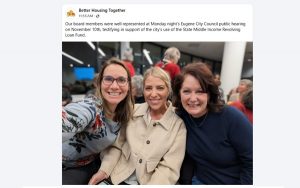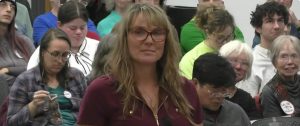City gets early feedback on proposed CAHOOTS-like services
2 min read
[00:00:00] Presenter: During public comment on Nov. 10, a response to the city’s plan for new CAHOOTS-like services:
[00:00:07] Michelle Perin: My name’s Michelle Perin. I’m a co-founder of Willamette Valley Crisis Care and a Navy veteran.
[00:00:12] First, I want to say thank you to the city manager, Chief Caven and Chief Skinner for the gaps analysis presented last week. It’s obvious that it was done with intention and care and that you truly listen to the community, the field responders, and subject matter experts.
[00:00:25] The information we were honored to share about our work as community responders and how this integrates into public safety, public health, and social needs landscape is evident in this analysis.
[00:00:35] And thank you to City Council for requesting this thoughtful evolution of services in our community and your future approvals.
[00:00:41] We notice there’s still some room for bridging of language, which is not uncommon when you work between disciplines like law enforcement, EMS, and behavioral health systems.
[00:00:49] This language translation is happening not only here but across the country as we solidify what it means to be a community responder. Where the analysis uses the words peer navigation, it’s obvious what it meant is non-law enforcement, non-clinician, peer-led care and support.
[00:01:03] This peer-led model is different than traditional peer support services, which generally focus on connecting over a single issue, such as substance use, and would never be safe or appropriate to manage hard-to-predict check welfare calls, which are a major gap this RFP intends to fill.
[00:01:19] It also misses the importance of the medical piece from the beginning of services. Mobile integrative health care has both the medical and behavioral health profession on the team, so we can treat a person as a whole person. One of the first things that needs to be done on any crisis call or any clinical intervention is to rule out a medical cause.
[00:01:37] Without a person on the team able to do this assessment and treat any nonemergent medical need, which often co-occurs with behavioral health or social service needs, we would not be as effective and would have to tax our EMS partners to come do this foundational piece for us.
[00:01:50] Due to this, we’re hoping that the Phase 1 and Phase 2 pieces described in the recommendation would be reconsidered and open to additional expertise and understanding.
[00:01:58] My final ask is for a more definitive timeline. Each day we’re losing our workforce to other jobs and other cities who are ready for us to bring community response to their area now.
[00:02:08] I also want to name that while we have the privilege to be in a safe, supportive space while discussing this critical need, many in our community are suffering alone, waiting for a CAHOOTS-like team to be available. Thank you.
[00:02:20] Presenter: Michelle Perin of Willamette Valley Crisis Care responds Nov. 10, after the city shares its gap analysis report.




